Having a toll-free number, also known as a freephone number or local rate number, attracts potential customers since it allows them to reach you without having to pay a call. Various toll-free numbers can be purchased from PRP Services Pvt Ltd at budget-friendly prices in India with different numbering plans. Often they are referred to as “1800 numbers,” “freephone numbers,” or LNP/LTABLE (local number portability) numbers.
What is a Toll-Free Number?
A toll-free number is a specialized telephone number that enables callers to connect with a business, organization, or individual without suffering any charges for the call. Unlike regular phone numbers where the caller pays for the call, with toll-free numbers, the recipient of the call (the business or entity that owns the toll-free number) assumes the cost of the incoming call.
Toll-free numbers are recognizable by their unique prefixes, which typically include 800, 888, 877, 866, and others. These prefixes indicate that the call is toll-free and that the caller will not be charged for dialing the number. Toll-free numbers can be dialed from landlines and mobile phones without any cost to the caller.
Businesses commonly utilize toll-free numbers for a variety of purposes, including customer service hotlines, sales inquiries, technical support lines, order placements, and general information lines. By offering toll-free numbers, businesses aim to make themselves more accessible to customers and prospects, regardless of their location or distance from the business’s physical location.
 How Business Toll-Free Service Works
How Business Toll-Free Service Works
Toll-free service works by providing callers with a way to contact a business or organization without suffering any charges for the call. Here’s how it typically operates:
- Purchase of a Toll-Free Number: A business or organization obtains a toll-free number from a telecommunications provider. These numbers are unique and are identified by specific prefixes like 800, 888, 877, 866, and others.
- Configuration of Routing Instructions: Once the toll-free number is purchased, the business configures routing instructions with their service provider. This involves specifying where incoming calls to the toll-free number should be directed. This destination could be a physical phone line, a call center, a virtual receptionist, or a VoIP system.
- Dialing the Toll-Free Number: When a customer or caller dials the toll-free number, the call is routed through the public switched telephone network (PSTN) to the destination specified by the business.
- Connection and Handling of the Call: The call is connected to the preferred destination, allowing the caller to communicate with the business or organization. Depending on the configuration set up by the business, the call may be answered by a live agent, an automated system, or directed to voicemail.
- Cost Responsibility: The business or organization that owns the toll-free number is responsible for paying the charges associated with incoming calls. This cost is typically based on factors such as the duration of the call and the origin of the caller.
- Tracking and Analytics: Toll-free service providers often offer tools and analytics to track the usage and performance of the toll-free number. This includes data on call volume, call duration, geographic location of callers, and more. Businesses can use this information to assess the effectiveness of their communication strategies and optimize their operations.
Who can use Toll-Free Numbers?
Toll-free numbers can be utilized by a wide range of authorities and individuals across various industries. Here are some examples of who can benefit from using toll-free numbers:
- Businesses of all sizes: Small, medium, and large businesses can use toll-free numbers to provide a free and accessible means for customers to contact them for inquiries, support, sales, and other purposes.
- Non-profit organizations: Charities, advocacy groups, and non-profit organizations can use toll-free numbers to facilitate communication with donors, volunteers, and individuals seeking assistance or information.
- Government agencies: Local, state, and federal government agencies can use toll-free numbers to provide citizens with access to government services, information hotlines, and assistance programs.
- Healthcare providers: Hospitals, clinics, doctors’ offices, and other healthcare providers can use toll-free numbers to offer patients a free and convenient way to schedule appointments, seek medical advice, and access healthcare services.
- Educational institutions: Schools, colleges, universities, and educational organizations can use toll-free numbers to provide students, parents, and faculty members with access to information, admissions assistance, and support services.
- E-commerce businesses: Online retailers and e-commerce platforms can use toll-free numbers to offer customer support, process orders, and address customer inquiries and concerns.
- Service providers: Companies offering services such as transportation, utilities, telecommunications, and hospitality can use toll-free numbers to enhance customer communication and support.
Benefits of using Toll-Free Numbers
Using toll-free numbers offers several benefits for businesses and organizations:

- Enhanced Accessibility: Toll-free numbers provide a free and convenient way for customers to reach a business from anywhere, without incurring long-distance charges. This accessibility improves customer satisfaction and encourages more frequent communication.
- Professional Image: Having a toll-free number adds credibility and professionalism to a business. It signals to customers that the business is established and committed to providing excellent customer service, which can help build trust and confidence in the brand.
- Improved Customer Service: Toll-free numbers streamline communication between businesses and customers, making it easier for customers to get assistance, place orders, or ask questions. This leads to faster resolution of issues, increased customer satisfaction, and higher retention rates.
- Brand Recognition: Toll-free numbers can be customized with pride numbers that incorporate the business name or a memorable phrase. This enhances brand visibility and recall, making it easier for customers to remember and contact the business.
- Marketing and Tracking: Toll-free numbers can be used in marketing campaigns to track response rates and measure the effectiveness of advertising efforts. By assigning different numbers to different marketing channels, businesses can identify which campaigns are driving the most calls and optimize their marketing strategies accordingly.
- Geographic Flexibility: Toll-free numbers allow businesses to expand their reach beyond local markets and attract customers from different regions or even countries. This geographical flexibility is particularly beneficial for businesses with a national or global presence.
- Cost-Effective Communication: While businesses pay for incoming calls to toll-free numbers, the cost is often by the benefits of improved customer service, increased sales, and enhanced brand reputation. Additionally, toll-free numbers can be affordable, with pricing plans hard to suit businesses of all sizes.
Features of Toll-Free Number
Toll-free numbers come with a variety of features designed to enhance communication, streamline operations, and improve customer service. Here are some common features you can expect from toll-free number service providers:
- Call Forwarding: Allows calls to be forwarded to a designated phone number, such as a mobile phone or landline, ensuring that calls are never missed, even when away from the office.
- Interactive Voice Response (IVR): Automated system that greets callers and directs them to the appropriate department or menu options based on their input, streamlining the call-routing process.
- Call Recording: Enables the recording of incoming calls for quality assurance, training purposes, or compliance with regulatory requirements.
- Voicemail to Email: Transcribes voicemail messages into text and sends them to a designated email address, allowing for easy access and organization of messages.
- Time-Based Routing: Routes calls based on specified time parameters, such as business hours or after-hours, ensuring that calls are handled appropriately at all times.
- Vanity Numbers: Customized toll-free numbers that incorporate memorable phrases or keywords related to the business, making it easier for customers to remember and dial the number.
- Call Analytics: Provides insights into call volume, duration, geographic origin of callers, and other metrics to track the effectiveness of marketing campaigns and optimize business operations.
- Online Management Portal: Web-based portal that allows users to manage their toll-free number account, access call logs, update routing configurations, and make changes to account settings.
- Conference Calling: Enables multiple parties to participate in a single call, smooth collaboration and communication among team members, clients, or partners.
- Mobile App Integration: Integration with mobile applications that allow users to make and receive calls using their toll-free number from their smartphone or tablet, providing flexibility and mobility.
How to get a Toll-Free Number in India
Getting a toll-free number in India is a straightforward process. Here’s a general overview of how to obtain a toll-free number:
- Choose a Service Provider: Research and select a reputable telecommunications service provider that offers toll-free number services in India. There are several providers available, including both traditional telecom companies and virtual number providers.
- Contact the Service Provider: Reach out to your chosen service provider through their website, or customer service hotline, or visit their local office. Inquire about their toll-free number services and discuss your specific requirements, such as the number of minutes needed, desired features, and pricing options.
- Select a Toll-Free Number: Once you’ve chosen a service provider, you’ll need to select a toll-free number. Toll-free numbers in India typically start with the prefix “1800” followed by six digits. You may have the option to choose a specific number or opt for a random selection, depending on availability.
- Provide Documentation: The service provider may require you to provide certain documents to verify your identity and business details. This could include proof of address, business registration documents, and identification proof.
- Customize Features: Discuss with the service provider the specific features and functionalities you’d like for your toll-free number. This could include call forwarding, IVR systems, call recording, voicemail-to-email, and more.
- Agree to Terms and Pricing: Review and agree to the terms and pricing structure offered by the service provider. This typically includes monthly subscription fees for incoming calls, additional features, and any usage beyond the allotted minutes.
- Activation and Setup: Once everything is finalized, the service provider will activate your toll-free number and assist you in setting up the routing configurations and desired features. You may receive login credentials to an online management portal where you can manage your toll-free number account.
- Promote Your Toll-Free Number: Start promoting your toll-free number to your customers and prospects through various channels, such as your website, marketing materials, social media, and advertising campaigns.
For more Information Contact us Now

